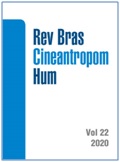Critical velocity estimates running velocity in a 10-km running race in recreational runners
DOI:
https://doi.org/10.1590/1980-0037.2020v22e59852Resumen
The aim of this study was to compare the estimated running velocity in a critical velocity (CV) test with the real running velocity in a 10-km race. This is a cross-sectional study with a convenience sample of 34 runners, 20 males and 14 females (42,4 ± 11,0). The participants attended two days of testing and one day to participate in an official 10-km race. During the visits, the following tests were performed: i) 400-meter running track test and ii) 2000 meter running track test. They were randomly selected and held in official athletics track with at least 48 hours rest between them. The athletes were instructed to participate in the study properly recovered, fed and hydrated. The CV was calculated as the linear relation between distance and race time, corresponding to the slope of the linear regression line. Both tests occurred in similar climatic situations. We found good agreement between the velocities estimated through the CV test and the real running velocity of a 10-km race. Although there was a difference in velocities estimated by the CV test and the real 10-km race, the variation delta was low. Thus, these data indicate that the CV test seems to be a good tool for estimating the velocity of a 10-km race. The CV determined in the field with two fixed distances 400 and 2000 meter was valid to estimate the running velocity of a 10-km race.
Citas
Knechtle B, Nikolaidis PT, Zingg MA, Rosemann T, Rüst CA. Half-marathoners are younger and slower than marathoners. Springerplus 2016;5(1):1–16.
Gómez-Molina J, Ogueta-Alday A, Camara J, Stickley C, Rodríguez-Marroyo JA, García-López J. Predictive variables of half-marathon performance for male runners. J Sport Sci Med 2017;16(2):187–94.
Anthony D, Rüst CA, Cribari M, Rosemann T, Lepers R, Knechtle B. Differences in Participation and Performance Trends in Age Group Half and Full Marathoners. Chin J Physiol 2014;57(4):209–19.
Santos TM, Rodrigues AI, Greco CC, Marques AL, Terra BS, Oliveira BRR. VO2max estimado e sua velocidade correspondente predizem o desempenho de corredores amadores. Rev Bras Cineantropom Desempenho Hum 2012;14(2):192–201.
Ogueta-Alday A, Gácia-López J. Factores que afectan al rendimiento en carreras de fondo Factors affecting long-distance running performance. Rev Int Cienc Deport 2015;11(41):226–44.
Santos MAM, Costa M, Brito-Gomes JL, Perrier-Melo RJ, Oliveira SFM, Farah BQ. Fatores Associados Ao Desempenho Em Uma Corrida De 10.000 Metros Em Corredores Amadores. J Phys Educ 2017;28(1):1–10.
Thiel C, Foster C, Banzer W, de Koning J. Pacing in Olympic track races: Competitive tactics versus best performance strategy. J Sports Sci 2012;30(11):1107–15.
Lima-Silva AE, Bertuzzi RC, Pires FO, Barros RV, Gagliardi JF, Hammond J, et al. Effect of performance level on pacing strategy during a 10-km running race. Eur J Appl Physiol 2010;108(5):1045-53.
Smith CGM, Jones AM. The relationship between critical velocity, maximal lactate steady-state velocity and lactate turnpoint velocity in runners. Eur J Appl Physiol 2001;85(1–2):19–26.
Denadai BS, Ortiz MJ, Stella S, Mello MT. Validade da velocidade crítica para a determinação dos efeitos do treinamento no limiar anaeróbio em corredores de endurance. Rev Port Ciênc Desporto 2003;2003(1):16–23.
Hiyane WC, Simões HG, Sílvia C, Campbell G. Critical velocity as a noninvasive method to estimate the lactate minimum velocity on cycling. Rev Bras Med Esporte 2006;12:340–4.
Wakayoshi K, Yoshida T, Udo M, Kasai T, Moritani T, Mutoh Y, et al. A Simple Method for Determining Critical Speed as Swimming Fatigue Threshold in Competitive Swimming. Int J Sports Med 1992;13(05):367–71.
Smith JC, Hill DW. Stability of Parameter Estimates Derived From the Power/Time Relationship. Can J Appl Physiol 1993;18(1):43–7.
Joseph L. Fleiss. Design and Analysis of Clinical Experiments. Willey; 1999. 448 p.
Souza KM De, Lucas RD De, Grossl T, Costa VP, Guilherme L, Guglielmo A. Performance prediction of endurance runners through laboratory and track tests. Rev Bras Cineantropom Desempenho Hum 2014:465–74.
Kranenburg KJ, Smith DJ. Comparison of critical speed determined from track running and treadmill tests in elite runners. Med Sci Sports Exerc 1996;28(5):614–8.
Léger LA, Boucher R. An indirect continuous running multistage field test: the Université de Montréal track test. Can J Appl Sport Sci 1980;5(2):77–84.
Hughson R, Orok C, Staudt L. A high velocity running test to assess endurance running potencial. Int J Sports Med 1984;5:23–5.
Magalhães Guedes, Juliano; Pierangeli Costa, Américo; Soares Pereira, Raphael José; Fernandes da Silva S. Sensibilidade da velocidade crítica em jovens nadadores durante um macrociclo de treinamento. Braz J Biomotricity 2011;5(3).
Pringle JSM, Jones AM. Maximal lactate steady state, critical power and EMG during cycling. Eur J Appl Physiol 2002;88(3):214–26.
Jones AM, Wilkerson DP, DiMenna F, Fulford J, Poole DC. Muscle metabolic responses to exercise above and below the “critical power” assessed using 31P-MRS. AJP Regul Integr Comp Physiol 2007;294(2):R585–93.
Jones AM, Vanhatalo A, Burnley M, Morton RH, Poole DC. Critical power: Implications for determination of VO2max and exercise tolerance. Med Sci Sports Exerc 2010;42(10):1876–90.
Descargas
Publicado
Número
Sección
Licencia

Direitos Autorais para artigos publicados nesta revista são do autor, com direitos de primeira publicação para a revista. Em virtude da aparecerem nesta revista de acesso público, os artigos são de uso gratuito, com atribuições próprias, em aplicações educacionais e não-comerciais, desde que seja dada a atribuição. Esta obra foi licenciada com uma Licença Creative Commons Atribuição 4.0 Internacional - CC BY


